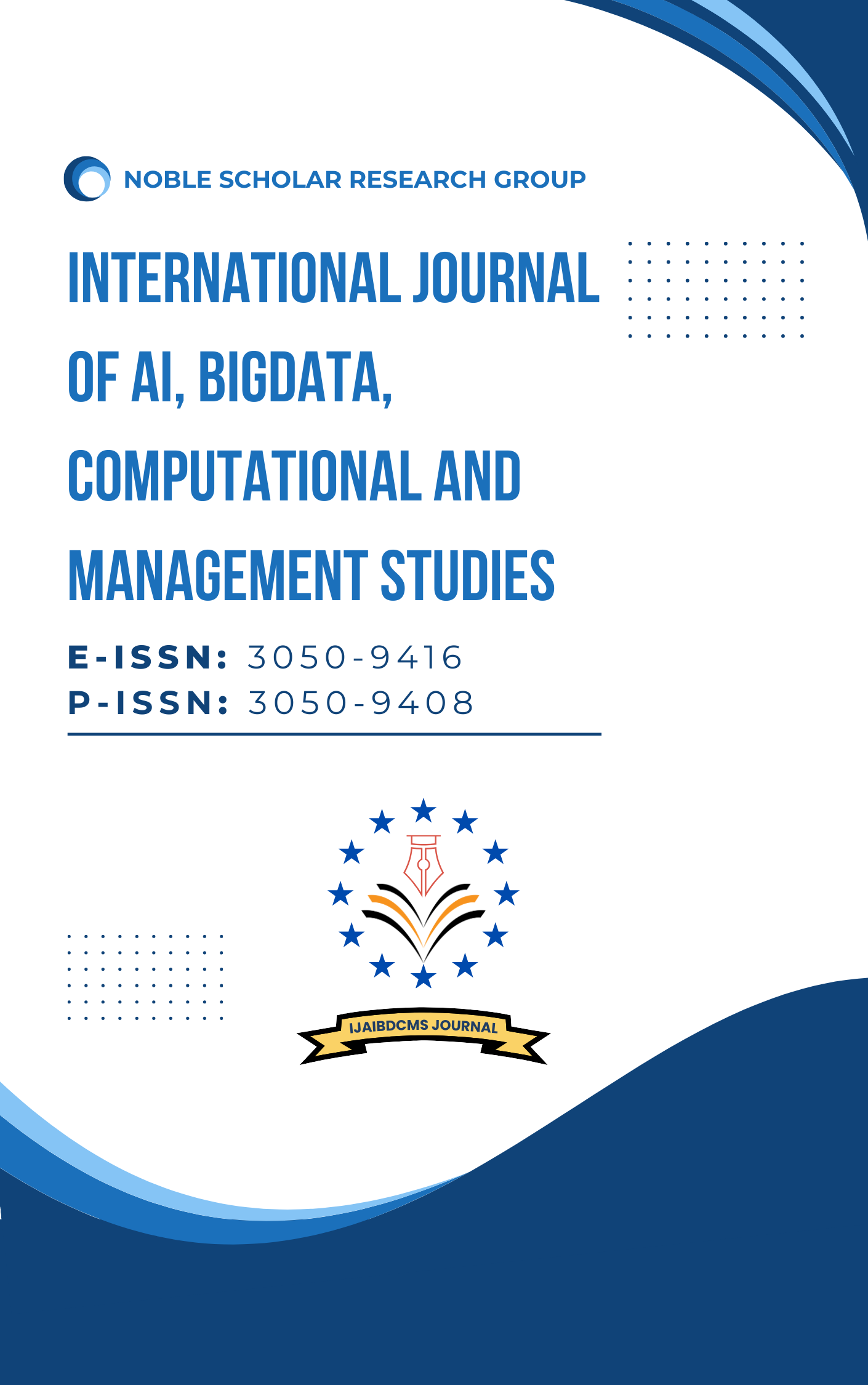Predictive Analytics in eCommerce: AI-Driven Insights for Market Trends and Consumer Behavior
DOI:
https://doi.org/10.63282/3050-9416.IJAIBDCMS-V2I3P104Keywords:
Predictive Analytics, e-commerce, Artificial Intelligence, Machine Learning, Consumer Behavior, Market Trends, Demand Forecasting, Customer Lifetime Value, Explainable AIAbstract
The digitalization that has taken place today has made it easier to identify markets and how customers behave. Predictive analytics in the modern world is one of the most valuable tools in the development of artificial intelligence, allowing decisions to be made based on big data. This paper aims to highlight options in the use of AI-based predictive models to predict market trends, optimize prices, and create customized experiences for consumers. Using structured and unstructured patterns from transactional databases and a product registry or social media logs, lurking, browsing behavior, and so on. AI can also discover relevant patterns, identify a shift, and make accurate estimations. The paper understands traditional market analysis methods, compares them with artificial intelligence, and compares modern approaches such as recommendation systems, demand forecasting systems, and customer lifetime value systems. It also covers a conceptually elegant model of real-time prediction for eCommerce, leveraged by tools of neural networks, NLP, and ensemble learning. Some evaluation criteria and case examples are presented, along with a discussion of ethical issues and potential difficulties in deployment. Lastly, the paper discusses potential work and further research ideas such as Explainable Artificial Intelligence, integration of Multiple Data Sources, and Real-Time Analysis. This study also seeks to provide practical information to practitioners and researchers interested in applying predictive analytics to competition in the current digital environment
References
1. Setyo, I. S. (2019). Traditional market management strategy in conditions of modern market development. Russian Journal of Agricultural and Socio-Economic Sciences, 94(10), 129-138.
2. Engström, F., & Nilsson Rojas, D. (2021). Prediction of the future trend of e-commerce.
3. Carta, S., Medda, A., Pili, A., Reforgiato Recupero, D., & Saia, R. (2018). Forecasting e-commerce product prices by combining an autoregressive integrated moving average (ARIMA) model and Google trends data. Future Internet, 11(1), 5.
4. Ward, M. R. (2002). On forecasting the demand for e-commerce. In Forecasting the Internet: Understanding the Explosive Growth of Data Communications (pp. 81-103). Boston, MA: Springer US.
5. Chaudhary, N., & Roy Chowdhury, D. (2019). Data preprocessing for evaluation of recommendation models in E-commerce. Data, 4(1), 23.
6. Suguna, S., Vithya, M., & Eunaicy, J. C. (2016, August). Big data analysis in e-commerce system using HadoopMapReduce. In 2016 International Conference on Inventive Computation Technologies (ICICT) (Vol. 2, pp. 1-6). IEEE.
7. Yu, H., Huang, X., Hu, X., & Wan, C. (2009, September). Knowledge management in E-commerce: A data mining perspective. In 2009 International Conference on Management of e-Commerce and e-Government (pp. 152-155). IEEE.
8. Sharma, G., & Lijuan, W. (2014). Ethical perspectives on e-commerce: an empirical investigation. Internet Research, 24(4), 414-435.
9. Smith, R., & Shao, J. (2007). Privacy and e-commerce: a consumer-centric perspective. Electronic Commerce Research, 7, 89-116.
10. Khoury, M., Shen, X., & Shirmohammadi, S. (2008). Accessibility and scalability in collaborative e-commerce environments. International Journal of Product Lifecycle Management, 3(2-3), 178-190.
11. Hasselbring, W., & Steinacker, G. (2017, April). Microservice architectures for scalability, agility, and reliability in e-commerce. In 2017 IEEE International Conference on Software Architecture Workshops (ICSAW) (pp. 243-246). IEEE.
12. Alsalama, A. M., Canlas, J. P., & Gharbi, S. H. (2016, September). An integrated system for drilling real-time data analytics. In SPE Intelligent Energy International Conference and Exhibition (pp. SPE-181001). SPE.
13. Milosevic, Z., Chen, W., Berry, A., Rabhi, F. A., Buyya, R., Calheiros, R. N., & Dastjerdi, A. V. (2016). Real-time analytics. Big Data: Principles and Paradigms, (2016), 39-61.
14. Liu, Y., Zhao, Z., Jiang, T., Wang, Y., Wu, S., & Zhe, W. (2021, September). A model fusion approach for goods information inspection in dual-platform e-commerce systems. In 2021 26th IEEE International Conference on Emerging Technologies and Factory Automation (ETFA) (pp. 01-08). IEEE.
15. Li, J., Dou, Z., Zhu, Y., Zuo, X., & Wen, J. R. (2020). Deep cross-platform product matching in e-commerce. Information Retrieval Journal, 23, 136-158.
16. Jasek, P., Vrana, L., Sperkova, L., Smutny, Z., & Kobulsky, M. (2019). Predictive performance of customer lifetime value models in e-commerce and the use of non-financial data. Prague Economic Papers, 28(6), 648-669.
17. Chamberlain, B. P., Cardoso, A., Liu, C. B., Pagliari, R., & Deisenroth, M. P. (2017, August). Customer lifetime value prediction using embeddings. In Proceedings of the 23rd ACM SIGKDD international conference on knowledge discovery and data mining (pp. 1753-1762).
18. Vanderveld, A., Pandey, A., Han, A., & Parekh, R. (2016, August). An engagement-based customer lifetime value system for e-commerce. In Proceedings of the 22nd ACM SIGKDD international conference on knowledge discovery and data mining (pp. 293-302).
19. Zulaikha, S., Mohamed, H., Kurniawati, M., Rusgianto, S., & Rusmita, S. A. (2020). Customer predictive analytics using artificial intelligence. The Singapore Economic Review, 1-12.
20. Khrais, L. T. (2020). Role of artificial intelligence in shaping consumer demand in E-commerce. Future Internet, 12(12), 226.
21. Kalia, P. (2021). Artificial intelligence in e-commerce: a business process analysis. In Artificial Intelligence (pp. 9-19). CRC Press.
22. Song, X., Yang, S., Huang, Z., & Huang, T. (2019, August). The application of artificial intelligence in electronic commerce. In Journal of Physics: Conference Series (Vol. 1302, No. 3, p. 032030). IOP Publishing.
23. Gochhait, S., Mazumdar, O., Chahal, S., Kanwat, P., Gupta, S., Sharma, R., ... & Sachan, R. (2020, May). Role of artificial intelligence (AI) in understanding the behavior pattern: a study on e-commerce. In ICDSMLA 2019: Proceedings of the 1st International Conference on Data Science, Machine Learning and Applications (pp. 1600-1606). Singapore: Springer Singapore.



